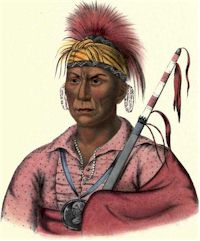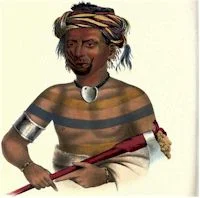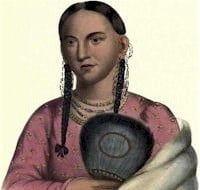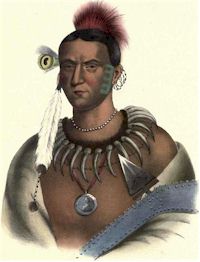Iowa Indians, Ioway Nation, Ioway Tribe (‘sleepy ones’). One of the southwestern Siouan tribes included by J. O. Dorsey with the Oto and Missouri in his Chiwere group. Traditional and linguistic evidence proves that the Iowa sprang from the Winnebago stem, which appears to have been the mother stock of some other of the southwestern Siouan tribes; but the closest affinity of the Iowa is with the Oto and Missouri, the difference in language being merely dialectic.
Iowa chiefs informed Dorsey in 1883 that their people and the Oto, Missouri, Omaha, anti Ponca “once formed part of the Winnebago nation.” According to the traditions of these tribes, at an early period they came with the Winnebago from their priscan home north of the great lakes, but that the Winnebago stopped on the shore of a great lake (Lake Michigan), attracted by the abundant fish, while the others continued southwestward to the Mississippi. Here another band, the Iowa, separated from the main group, “and received the name of Pahoja, or Gray Snow, which they still retain, but are known to the white people by the name of Ioway, or Aiaouez. The first stopping place of the Iowa, after parting from the Winnebago, as noted in the tradition, appears to have been on Rock River, Illinois, near its junction with the Mississippi. Another tradition places them farther north.
In 1848 a map was drawn by a member of the tribe showing their movements from the mouth of Rock river to the place where they were then living. According to this their first move was to the banks of Des Moines River, some distance above its mouth; the second was to the vicinity of the pipestone quarry in southwest Minnesota, although on the map it was placed erroneously high up on the Missouri; thence they descended to the mouth of Platte river, and later moved successively to the headwaters of Little Platte river, Missouri; to the west bank of the Mississippi, slightly above the mouth of Des Moines river, a short distance farther up on the same side of the Mississippi; again southwesterly, stopping on Salt River, thence going to its extreme headwaters; to the upper part of Chariton River; to Grand River; thence to Missouri River, opposite Ft Leavenworth, where they lived at the time the map was drawn. These successive movements, which are of comparatively recent date, are generally accepted as substantially correct. The Sioux have a tradition 1 that when their ancestors first came to the falls of St Anthony, the Iowa occupied the country about the mouth of Minnesota river, while the Cheyenne dwelt higher up on the same stream. The Iowa appear to have been in the vicinity of the mouth of Blue Earth River, Minnesota, just before the arrival there of Le Sueur in 1701 for the purpose of erecting his fort. His messengers, sent to invite them to settle in the vicinity of the fort because they were good farmers, found that they had recently removed toward Missouri river, near the Maha (Omaha), who dwelt in that region. The Sioux informed Le Sueur that Blue Earth river belonged to the Scioux of the West (Dakota), the Ayavois (Iowas), and Otoctatas (Oto), who lived a little farther off. Father Marest 2 says that the Iowa were about this (late associated with the Sioux in their war against the Sauk. This does not accord with the general tradition that the Dakota were always enemies of the Iowa, nevertheless the name Nadoessi Maseouteins seems to have been applied to the Iowa by the early missionaries because of their relations for a time with the Sioux. Pere Andre thus designated them in 1676, when they were living 200 leagues west of Green Bay, Wis. Perrot 3 apparently located them in the vicinity of the Pawnee, on the plains, in 1685. Father Zenobius (1680) placed the Anthoutantas (Oto) and Nadouessious Maskoutens (Iowa) about 130 leagues from the Illinois, in 3 great villages built near a river which empties into the river Colbert (Mississippi) on the west side, above the Illinois, almost opposite the mouth of the Wisconsin. He appears to locate a part of the Ainoves (perhaps intended for Aioues), on the west side of Milwaukee river, in Wisconsin. On Marquette’s map (1674-79) the Pahoutet (Iowa), the Otontanta (Oto), and Maha (Omaha) are placed on Missouri river, evidently by mere guess. La Salle knew of the Oto and the Iowa, and in his letter in regard to Hennepin, Aug. 22, 1682, mentions them under the names Otoutanta and Aiounouea, but his statement that Accault, one of his company, knew the languages of these tribes is doubtful. It is probable that in 1700, when Le Sueur furnished them with their first firearms, the Iowa resided on the extreme headwaters of Des Moines river, but it appears from this explorer’s journal that they and the Oto removed and “established themselves toward the Missouri river, near the Maha.” Jefferys 4 placed them on the east side of the Missouri, west of the sources of Des Moines river, above the Oto, who were on the west side of the Missouri and below the Omaha; but in the text of his work they are located on the Mississippi in lat. 43º 30′.
In 1804, according to Lewis and Clark 5 they occupied a single village of 200 warriors or 800 souls, 18 leagues up Platte river, on the south east side, although they formerly lived on the Missouri above the Platte. They conducted traffic with traders from St Louis at their posts on Platte and Grand Nemaha river, as well as at the Iowa village, the chief trade being skins of beaver, otter, raccoon, deer, and bear. They also cultivated corn, beans, etc. In 1829 6 they were on Platte river, Iowa., 15 m. from the Missouri state line. Schoolcraft (1853) placed them on Nemaha river, Nebr., a mile above its mouth. By 1880 they were brought under the agencies.
The visiting and marriage customs of the Iowa did not differ from those of cognate tribes, nor was their management of children unlike that of the Dakota, the Omaha, and others. They appear to have been cultivators of the soil at an early date, as Le Sueur tried to persuade them to fix their village near Ft Sueurr because they were “industrious and accustomed to cultivate the earth.” Pike says that they cultivated corn, but proportionately not so much as the Sauk and Foxes. He also affirms that the Iowa were less civilized than the latter. Father Andre 7 says that although their village was very large, they were poor, their greatest wealth consisting of “ox-hides and red calumets,” indicating that the Iowa early manufactured and traded catlinite pipes. Some small mounds in Minnesota and Iowa have been ascribed to them by two distinct traditions.
In 1824 they ceded all their lands in Missouri, and in 1836 were assigned a reservation in north east Kansas, from which a part of the tribe moved later to another tract in central Oklahoma, which by agreement in 1890 was allotted to them in severalty, the surplus acreage being opened to settlement by whites.
Various estimates of the population of the Iowa at different dates are as follows: In 1760, 1,100 souls; by Lewis and Clark in 1804, 800, smallpox having carried off 100 men besides women and children in 1803; the Secretary of War gives the number in 1829 as 1,000; Catlin in 1832 at about 1,400, but in 1836 at 992; the Indian Affairs Report of 1843 gives their number as 470; the number at the Potawatomi and Great Nemaha agency in Kansas was 143 in 1884, 138 in 1885, 143 in 1886, and 225 in 1905. At the latter date they were under the jurisdiction of the Kickapoo School. At the Sauk and Fox agency, Okla., in 1885 they numbered 88; in 1901, 88; in 1905, 89.
There was an Iowa village called Wolf village.
Ioway Tribe Images
These images will give you an idea of the dress, jewelry, head-pieces, weapons, and other accessories that were often worn by the Ioway Tribe.

Young Mahaskah, An Ioway Chief 
Watchemonne, The Orator, Third Ioway Chief 
Tahrohon, An Ioway Warrior 
Shauhaunapotinia, Man who killed three Sioux, An Ioway Chief 
Rantchewaime, Female Flying Pigeon, Wife of Mahaskah, Ioway Indian 
Notchimine No Heart An Ioway Chief 
Mahaskah or White Cloud An Ioway Chief 
Moanahonga, Great Walker, An Ioway Brave 
Neomonni, Fifth Ioway Chief
Ioway Tribe Locations
- Iowa Indian Tribes – Swanton
- Minnesota Indian Tribes – Swanton
- Nebraska Indian Tribes – Swanton
- Oklahoma Indian Tribes – Swanton
- Wisconsin Indian Tribes – Swanton
Ioway Tribe Treaties
- Treaty of September 16, 1815
- Treaty of August 4, 1824
- Treaty of August 19, 1825
- Treaty of July 15, 1830
- Treaty of September 17, 1836
- Treaty of November 23, 1837
- Treaty of October 19, 1838
- Treaty of May 17, 1854
- Treaty of March 6, 1861
Additional Ioway History
- Houses of the Iowa Tribe
- Indian Missions of Middle Atlantic States
- Iowa Indian Chiefs and Leaders
- Native American Land Patents
- Missouri Tribe – Hodge
- Oto Tribe – Hodge
- Indian History of Winneshiek County, Iowa
Free US Indian Census Schedules 1885-1940
- Free US Indian Census Schedules 1885-1940
- Haskell Agency
- Kickapoo Agency
- Potawatomi Agency
Ioway Tribe Genealogy
- 1830-1860: The Story of the Nemaha Half-Breed Reservation, 1830-1860
- Land patents and allotments, 1855-1928
The Potawatomi Agency directed the affairs of the Iowa, Kickapoo, Potawatomi and Sac and Fox reservations in Kansas. Includes some records of Chippewa and Munsee Indians. Microfilm contents:- List of half breed patents issued 1861-1862
- Patent fees 1860-1866
- Bids for allotments 1864
- Allotment registers 1855, 1859, 1863, 1892-1928
- 1856-1857 Nemaha Half-breed Allotments
- 1860: Allottees on the Nemaha Half-Breed Reservation, 1860
- 1870 Great Nemaha Agency Census by Thomas Lightfoot of the Ioway.
- 1889 Census of the Iowa Indians of Sac and Fox Agency, Ind. Ter.
- 1889 Ioway Annuity
- 1890 Census of the Iowa Indians of Sac and Fox Agency, I. Ty. taken by Samuel L. Patrick, United States Indian Agent, June 30th, 1890.
- 1891 Census of the Ioway Indians of Pottawatomie and Gt. Nemaha Agency
- 1891 Census of Iowa Tribe of Indians of Sac and Fox Indian Agency, Oklahoma Territory
- 1892: List of Landowners in 1892 on Iowa Reservation, Kansas and Nebraska
- 1891-1892 Allotment Roll, Ioway Nation of Kansas and Nebraska.
- 1892 Census of the Ioway (in Oklahoma) Indians of Sac and Fox Agency, OK. Ty.
- 1892 Census of the Ioway in Kansas
- Probate records, 1859-1914: FHL Film 1015900
The Potawatomi Agency directed the affairs of the Iowa, Kickapoo, Potawatomi and Sac and Fox reservations in Kansas. Includes some indexes.- Heirship and death records 1892-1908
- Heirship and death records 1912-1918
- Affidavits to lawful heirs 1889-1914
- List of allottees (heirships)
- File to determine heirs
- Land sales (heirships) 1902-1911
- Cash book index 1859-1860
- Cash book (heirships) 1867-1868
- 1895 Census of the Ioway (in Oklahoma) Indians of Sac and Fox Agency, OK. Ty.
- 1900 Brown County Kansas Census, FHL Film #1240472 (also includes Sac/Fox)
- 1900 Lincoln Co. Oklahoma Census, FHL Film # 1241339, (pages 38A and 80A and 93A)
- 1900 Oklahoma Kay County Census, Chilocco School FHL Film # 1241338 Pages 125A and 190A
- 1900 Richardson County Nebraska Census, Microfilm FHL Film # 1240938
- List of names from George Nuzum’s 1906 biography of the Iowa Indians of Kansas & Nebraska
- Iowa, Sac, Fox, Kickapoo, Potawatomi deaths and births, 1924-1934: FHL Film # 0576865 and 0576866
Includes the following:- Indian census rolls, Haskell, 1927-1931
- 1927-1930: Potawatomi, Kickapoo, Iowa, Sac and Fox (not always in that order
- 1931: Potawatomi, Kickapoo, Iowa, Sac and Fox and supplemental rolls for additions, deductions, deaths, births (1924-1931)
- 1932-1934: Potawatomi, Kickapoo, Iowa, Sac and Fox with supplemental rolls for additions, deductions, births, deaths
- Indian census rolls, Haskell, 1927-1931
- 1941: Iowa Reservation (KS-NE) Landowners in 1941
- Nebraska, World War I Selective Service System draft registration cards, 1917-1918
- Nebraska Indians: FHL Film # 2022391 Item 3 (whole state);
- Richardson County A-D, film 1711767, E-Z FHL Film #1711768;
- Iowa Indians: FHL Film # 2022388 Item 2 (whole state);
- Kansas Indians: FHL Film # 2022388 Item 3 (whole state);
- Nemeha County A-S FHL Film # 1643726;
- Nemaha County T-Z FHL Film # 1643727;
- Brown County FHL Film # 1643424
For Further Study
The following articles and manuscripts will shed additional light on the Iowa as both an ethnological study, and as a people.
- Catlin, Iowa Indians, 1844;
- Dorsey (1) in 11th Rep. B. A. E., 1894, and 15th Rep. B. A. E., 1897,
- Dorsey (2) Trans. Anthrop. Soc. Wash., 11, 1883;
- Hamilton and Irvin, loway Gram., 1848;
- Hayden, Ethnog. and Philol. Mo. Val., 1862;
- Lewis and Clark, Orig. Jour., i-vim, 1904-05;
- Long, Exped. Rocky Mts.,1,1823;
- Minn. Hist. Soc. Coll., 1, 1872;
- Sen. Doc. 452, 57th Cong., 1st sess., H, 1903
Citations:
- Williamson in Minn. Hist. Coll., 1, 296[↩]
- La Harpe, Jour., 39, 1851[↩]
- Perrot, Mém., 63, 1864[↩]
- Jefferys, Fr. Dom. in Am., 1761[↩]
- Lewis and Clark, Orig. Jour., vi, 91-92, 1905,[↩]
- Morse, Rep. Sec. War[↩]
- Jes. Rel., 1676, Thwaites ed., LX, 203, 1900[↩]









